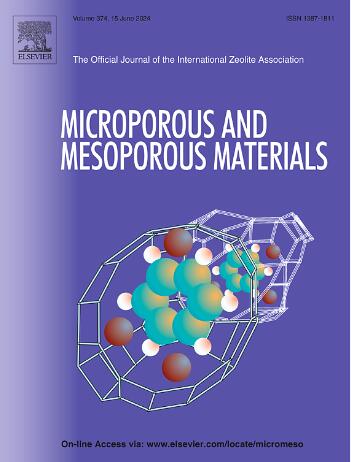Calcination effects on meta-forms of kaolin and halloysite: Role of Al-Si spinel crystallization in zeolite synthesis
IF 4.7
3区 材料科学
Q1 CHEMISTRY, APPLIED
引用次数: 0
Abstract
The role of Al-Si spinel crystallization during high-temperature calcination of kaolin and halloysite was investigated to optimize the direct synthesis of zeolites 4A and 13X without additional silica or structure-directing agents. Differential thermogravimetry (DTG) and in situ synchrotron X-ray diffraction (SR-XRD) tracked dehydroxylation and Al-Si spinel crystallization, revealing complete dehydroxylation at 575 °C for kaolin and 500 °C for halloysite, with spinel crystallization occurring in a range of 900–940 °C for both clays. Calcination promoted the formation of Al-Si spinel and amorphous silica, increasing the Si/Al ratio and enabling control of zeolite composition and porosity. Calcination conditions determined the zeolite type, evolving from pure 4A to a mixture of 4A/13X, and finally pure 13X. The presence of Al-Si spinel in 13X enhanced mesoporosity, introducing voids and channels between micropores and contributing to high BET surface areas (>500 m2/g) with a dual micro/mesoporous structure. This study establishes a direct link between calcination parameters and zeolite properties, highlighting Al-Si spinel's role in phase transitions and porosity development. These findings provide valuable insights for optimizing industrial applications such as adsorption and catalysis.

煅烧对高岭土和高岭土元形态的影响:铝硅尖晶石结晶在沸石合成中的作用
研究了Al-Si尖晶石结晶在高岭土和高岭土高温煅烧过程中的作用,以优化直接合成4A和13X分子筛,而无需添加二氧化硅或结构导向剂。差示热重(DTG)和原位同步x射线衍射(SR-XRD)跟踪了脱羟基作用和Al-Si尖晶石结晶,发现高岭土在575°C和高岭土在500°C时完全脱羟基作用,尖晶石结晶在900-940°C范围内发生。煅烧促进了Al-Si尖晶石和无定形二氧化硅的形成,提高了Si/Al比,有利于控制沸石的组成和孔隙度。煅烧条件决定了沸石的类型,从纯4A到4A/13X的混合物,最后是纯13X。Al-Si尖晶石在13X中的存在增强了介孔,在微孔之间引入了空隙和通道,并以双微孔/介孔结构贡献了高BET表面积(>500 m2/g)。本研究建立了煅烧参数与沸石性质之间的直接联系,突出了Al-Si尖晶石在相变和孔隙发育中的作用。这些发现为优化吸附和催化等工业应用提供了有价值的见解。
本文章由计算机程序翻译,如有差异,请以英文原文为准。
求助全文
约1分钟内获得全文
求助全文
来源期刊

Microporous and Mesoporous Materials
化学-材料科学:综合
CiteScore
10.70
自引率
5.80%
发文量
649
审稿时长
26 days
期刊介绍:
Microporous and Mesoporous Materials covers novel and significant aspects of porous solids classified as either microporous (pore size up to 2 nm) or mesoporous (pore size 2 to 50 nm). The porosity should have a specific impact on the material properties or application. Typical examples are zeolites and zeolite-like materials, pillared materials, clathrasils and clathrates, carbon molecular sieves, ordered mesoporous materials, organic/inorganic porous hybrid materials, or porous metal oxides. Both natural and synthetic porous materials are within the scope of the journal.
Topics which are particularly of interest include:
All aspects of natural microporous and mesoporous solids
The synthesis of crystalline or amorphous porous materials
The physico-chemical characterization of microporous and mesoporous solids, especially spectroscopic and microscopic
The modification of microporous and mesoporous solids, for example by ion exchange or solid-state reactions
All topics related to diffusion of mobile species in the pores of microporous and mesoporous materials
Adsorption (and other separation techniques) using microporous or mesoporous adsorbents
Catalysis by microporous and mesoporous materials
Host/guest interactions
Theoretical chemistry and modelling of host/guest interactions
All topics related to the application of microporous and mesoporous materials in industrial catalysis, separation technology, environmental protection, electrochemistry, membranes, sensors, optical devices, etc.
 求助内容:
求助内容: 应助结果提醒方式:
应助结果提醒方式:


